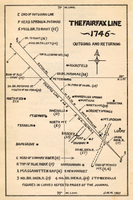 | Back to e-WV
| Back to e-WV
 The West Virginia Encyclopedia
The West Virginia Encyclopedia
 | Back to e-WV
| Back to e-WV
 The West Virginia Encyclopedia
The West Virginia Encyclopedia

The Fairfax Lands originated in a 1649 grant by King Charles II to seven loyal supporters, of all of the land in the colony of Virginia between the Rappahannock and Potomac rivers from their head waters to the Chesapeake Bay. By 1719, through purchases and inheritance, Lord Thomas Fairfax became sole proprietor. His domain included most of the Eastern Panhandle and Potomac Highlands of present West Virginia.
Under the royal grant, the proprietor was given governing rights. There was some dissatisfaction between the colony and Fairfax, and in 1733 the Virginia General Assembly attacked the proprietorship and its boundaries. In 1736, to establish the bounds of the grant, surveyors for Fairfax and Virginia followed the North Branch of the Potomac River to what they determined to be the Potomac’s source, a small spring between Backbone Mountain and Dobbin Ridge in present Tucker County. In 1746, a second surveying party established the Fairfax Line from the headwaters of the Rappahannock in the Blue Ridge Mountains to this spring, where they placed a stone marker known thereafter as the Fairfax Stone. The vast region between the rivers was called the Northern Neck, although in modern times the name applies only to the section between the lower Potomac and Rappahannock, in Tidewater Virginia.
The Fairfax Line completed the boundaries of the royal grant. In England, Fairfax successfully defended the boundaries established by these surveys, and the British Board of Trade confirmed that he was entitled to the quitrents or taxes from the holdings. In 1747, Fairfax moved permanently to Virginia, and in 1752 established his residence, Greenway Court, near Winchester. George Washington had profitable associations at Greenway Court, in both his professional capacity as a surveyor and in the social context of the day, which included deer hunting and fox hunting with Fairfax.
Settling the boundary lines brought greater growth to established communities, including Alexandria, and the establishment of new communities in the Piedmont and the lower Shenandoah Valley, including Leesburg, Fairfax, Woodstock, Strasburg, Romney, and Mecklenburg (now Shepherdstown). The bounds of the proprietary encompassed a tremendous tract of five million acres. The Fairfax Lands included present Jefferson, Berkeley, Morgan, Hardy, Hampshire, and Mineral counties, and parts of Grant and Taylor.
Residents on the Fairfax Lands were required to pay an annual fee, or quitrent, to hold their land. This amounted to the paying of taxes to the lord of the manor, a feudal custom offensive to Revolutionary Americans. In 1776, Virginia abolished quitrents but nonetheless excepted Fairfax’s proprietary. In 1779, during the Revolutionary War, Virginia seized property belonging to British subjects in the state but again excluded Fairfax; he was not classed as a British subject and did not take an active part for or against the Revolution. Fairfax died in 1781, and the Virginia Assembly, concerned that British subjects might inherit the holdings, abolished the proprietary in 1785.
Written by Gilbert Gude
Brown, Stuart E. Jr. Virginia Baron. Berryville, VA: Chesapeake Book Co., 1965.
Morrison, Charles. The Fairfax Line. Parsons: McClain, 1970.